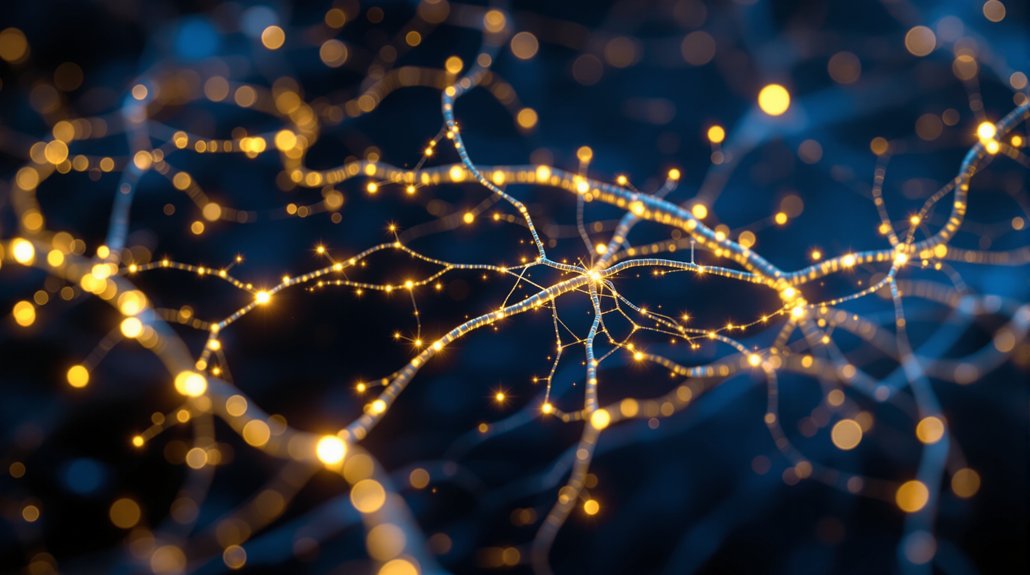Scientists have uncovered a biological network that most people never knew existed, yet it influences nearly every aspect of human health. The endocannabinoid system operates like a hidden conductor orchestrating the body’s delicate balance between pain and pleasure, hunger and satiety, stress and calm. This complex communication network, discovered only in the 1990s, helps explain why certain medical treatments work and why others fail spectacularly. The implications for modern healthcare may fundamentally reshape treatment approaches.
What Is the Endocannabinoid System and Why Does It Matter?

Discovery often arrives through unexpected doorways, and the endocannabinoid system is an example of this scientific truth. Scientists stumbled upon this intricate cellular network during late 20th-century cannabis research, uncovering what would become recognized as a master regulator of human homeostasis.
The endocannabinoid system operates as a sophisticated neuromodulatory network, orchestrating balance across multiple organ systems through endogenous cannabinoids, specialized receptors, and metabolic enzymes. This biological machinery influences everything from mood and sleep cycles to pain perception and inflammatory responses. Unlike other signaling molecules, endocannabinoids are produced as needed by the body rather than stored in advance, making their levels highly variable based on physiological demand.
The endocannabinoid system functions as the body’s master conductor, harmonizing physiological processes from neural signaling to immune regulation through precise molecular orchestration.
The system’s reach extends far beyond initial expectations, CB1 and CB2 receptors populate the brain, immune cells, connective tissues, and skin. Two primary endocannabinoids, Anandamide and 2-AG, serve as the body’s natural signaling molecules that activate these widespread receptor networks.
Modern research reveals an expanded endocannabinoidome incorporating additional lipid mediators and receptor types. Scientists continue mapping this complex system, recognizing its therapeutic potential for conditions ranging from chronic pain to neurodegenerative disorders.
The Key Players: Receptors, Endocannabinoids, and Enzymes Working Together
Three distinct molecular players orchestrate the endocannabinoid system‘s complex symphony of cellular communication.
CB1 and CB2 receptors serve as the primary listening posts. CB1 receptors populate brain regions like the hippocampus and cortex, while CB2 receptors station themselves on immune cells throughout peripheral tissues. These G protein-coupled receptors act like cellular switches, modulating everything from neurotransmitter release to inflammation responses. In the brain, CB1 receptors actually outnumber many other receptor types, demonstrating their critical importance in neural regulation.
The star messengers are anandamide and 2-AG, endocannabinoids synthesized on-demand from cell membrane lipids. Unlike traditional neurotransmitters, these molecules travel backward across synapses, creating unique feedback loops that regulate neural activity. Notably, 2-AG serves as a high-efficacy agonist for both receptor types, while anandamide demonstrates lower efficacy.
The cleanup crew consists of specialized enzymes. FAAH breaks down anandamide, while MAGL dismantles 2-AG, ensuring signals remain precisely timed and localized—preventing cellular chaos. Dysfunction in this finely tuned system has been strongly linked to various neurodegenerative conditions including Alzheimer’s and Parkinson’s disease.
Your Body’s Master Regulator: Functions Controlled by the ECS

Like a sophisticated thermostat that monitors and adjusts every room in a smart home, the endocannabinoid system operates as the body’s master regulatory network, maintaining ideal function across virtually every physiological process.
This biological regulator fine-tunes appetite signaling, metabolism, and digestive functions through strategic CB1 receptor activation in the brain.
Pain modulation represents another vital function, the ECS controls both acute and chronic pain while dampening inflammatory responses via CB2 receptors on immune cells.
The system’s influence extends to mood regulation, stress response, and memory formation, particularly the significant ability to forget unnecessary information.
Sleep cycles, motor coordination, and cardiovascular function also fall under ECS control.
When this network malfunctions, homeostatic disruptions emerge, linking ECS dysregulation to metabolic disorders, chronic pain conditions, and neuropsychiatric diseases.
Medical Breakthroughs: How ECS Research Is Changing Healthcare
How quickly can revolutionary medical discoveries transform patient care? ECS research is delivering breakthrough treatments faster than many anticipated.
Over 160 cannabis-related studies published in early 2025 revealed cannabinoids like CBD, CBG, and CBN effectively reduce activity of the Nav1.8 protein, a key player in peripheral pain signaling. This offers genuine alternatives to opioids with dramatically reduced addiction risk.
CBG demonstrated the strongest pain signal inhibition among tested cannabinoids. Meanwhile, CBD considerably reduced seizure frequency in CDKL5 epilepsy models and protected cartilage cells from inflammatory damage.
Clinical trials using vaporized cannabinoids (13% CBD, 9% THC) showed remarkable improvements in multiple sclerosis symptoms.
Perhaps most promising: a 2024 human trial found 20mg hemp-derived CBG considerably reduced anxiety without intoxication, potentially revolutionizing mental health treatment approaches. Additionally, CBD demonstrated significant effectiveness in reducing thunderstorm-related anxiety in cats, suggesting broader therapeutic applications across species. The research addresses the critical need for safer pain management options, as the opioid epidemic continues to claim over 80,000 lives annually in the United States.










